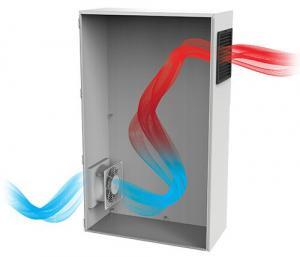Most people are aware that electrical and electronic components are heat-sensitive, and that their life expectancies can be reduced significantly if they are not kept within specified operating temperatures. Typical upper limits for specified operating temperatures are 40°C (104°F); occasionally 50°C (122°F). One common application challenge is maintaining temperature below these upper limits within a control enclosure. There are a number of variables which need to be considered when determining the cooling needed, including the size of the enclosure, its material and finish, its location (e.g. outdoors in shade or sun), and, in general, the variability of the ambient temperature during operating periods. Note that all of these factors are in addition to the the impacts of the internal components and their heat loads; i.e. the heat they give off during operation. Today we’ll examine these factors and look at one cost-effective means for addressing them – forced air cooling, also known as fan-forced air (FFA) or forced convective cooling.

First, let’s look at the formula to calculate the amount of forced air cooling needed. This formula can be adapted for a wide variety of conditions:
CFM = (3.16 x W) / ΔT (°F)
Where:
W = Internal Heat Load in Watts
ΔT = Internal Temperature minus Ambient Temperature in °F
CFM = Required airflow in cu. ft/min.
When it comes to using this formula, as with life in general the devil is in the details. Firstly, let’s consider internal heat load in watts (W). In many cases, the manufacturers’ specs for each internal component will list the heat loss in watts. Where the specs do not indicate this, estimates can usually be derived. Take variable speed drives, for example. Most manufacturers specify heat loss in the VSD installation/operation manual. Where this is not available, loss in watts can be calculated using the drive’s operating efficiency at rated load. So for instance, a 50hp drive operating at 97% efficiency is losing 3% of 50hp, or 1.5hp x 746W/hp = 1,119W. Don’t forget that the drive’s efficiency can change based on percent loading; a drive operated for an extended period of time at low speed will not be as efficient as a fully loaded drive, so the losses will be greater.
Also, when totaling up internal heat load, don’t forget to include all other heat-generating components – transformers, coils, circuit breakers, braking resistors, etc. Finally – and this is critical – you need to factor in the enclosure’s ability to dissipate heat to the outside. A metallic enclosure out in the sun will heat up very quickly internally, such that the heat generated by the components will have no where to go. This creates escalating heating within the box, and without a way to dissipate this heat will result in drastically reduced component lifetimes. It is not uncommon to see temperatures which exceed even an AC unit’s ability to correct. This is why when a panel is to be installed outdoors, it is always recommended to either locate it in a consistently shady location, or build some type of shelter around it.
When calculating cooling requirements, it is extremely useful to use an online cooling calculator. They are available from a number of manufacturers; one from Saginaw Controls and Engineering is here.
The ΔT in the above formula is driven as much by the outside (ambient) temperature as by the internal enclosure temperature. In fact, from the previous paragraph it is clear that internal temperature is partly a function of the surrounding air. That is why the temperature of the surrounding air is so important. Because forced air cooling uses the movement of air to cool the internal components, the temperature of the moving air needs to be low enough to be able to absorb a lot of the heat created inside the enclosure. A fan bringing in ambient air with a temperature of 32°C (90°F) can, in the best case, reduce component temperatures to that temperature; this might be OK for the external surfaces of the components but not help to reduce their internal heating much. Good design practice says that you should try to maintain the temperature in the inside of the enclosure to about 20°F below the maximum operating temperature of the lowest rated component, which typically means about 29°C (84°F). This allows for adequate cooling of all the electronics inside the components. This is sometimes difficult to achieve in practice because of operating conditions inside many industrial facilities. In those cases, it may make economic sense to opt for a refrigerant cooling system or, in some cases, an air-to-water heat exchanger. What usually does NOT make sense is to try to get by with inadequate cooling; this most frequently leads to frustrating and costly operating downtime.
Have you faced the difficult decision of spending beyond budget because -adequate cooling was not considered? Does your application present cooling challenges? Let us know about it in the Comments, section, and let Joliet Technologies assist. To learn more, visit us on the web; email us, or give us a call Toll Free at 866-492-9888. We have decades of experience in the proper design and application of all types of enclosure cooling systems, and can provide a cost-effective solution for you.
Thanks for reading, and til next time, stay cool!

Regards,
Jay Baima
Joliet Technologies


Leave A Comment
You must be logged in to post a comment.